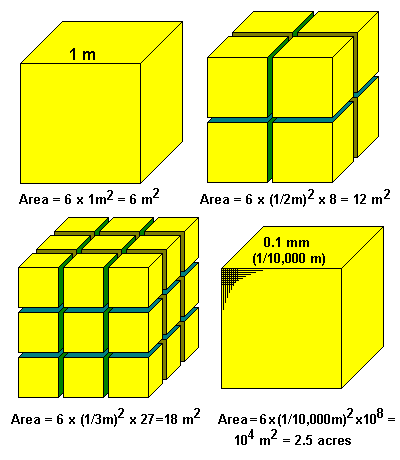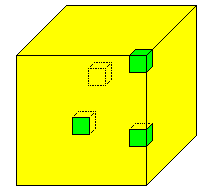Weathering and Soils
Steven Dutch, Natural and Applied Sciences, University of Wisconsin - Green Bay
First-time Visitors: Please visit Site
Map and Disclaimer. Use "Back" to return here.
The Rock Cycle

The Ideal Rock Cycle
- Igneous rocks form when molten rock
(magma) invades the crust.
- They break down by weathering and the breakdown
products are transported by erosion.
- The breakdown products are deposited to form sedimentary
rocks
- Sedimentary rocks are buried, subjected to heat, pressure,
and the action of fluids
- Heat, pressure, and the action of fluids change rocks,
forming metamorphic rocks.
- Metamorphic rocks may eventually be heated enough to melt,
forming a new generation of igneous rocks.
Anything can happen in the Rock Cycle
- Igneous rocks can be subjected to heat, pressure,
and the action of fluids to form metamorphic rocks.
- Igneous rocks can be re-melted, forming a new
generation of igneous rocks.
- Sedimentary rocks can be weathered and
eroded to form a new generation of sedimentary
rocks.
- Sedimentary rocks may eventually be heated enough
to melt, forming a new generation of igneous rocks
(although technically they'd be metamorphic by the time
they melted).
- Metamorphic rocks can be weathered and eroded to
form sedimentary rocks.
- Metamorphic rocks can be subjected to heat,
pressure, and the action of fluids to form a new
generation of metamorphic rocks.
Weathering
Breakdown of Rock near the Surface Due to Surface Processes
- Chemical Alteration (Often Addition of Water)
- Solution & Leaching
- Biological Action
- Hydration
- Mechanical
- Impact
- Frost - Wedging
- Plant Roots
- Salt Crystal Growth
- Expansion of Hydrated Minerals
Movement of Large Amounts of Material Downhill under Gravity
- Creep
- Mudflows
- Slump
- Rockfalls
- Avalanches
Surface Area and Weathering
Imagine a cube of rock one meter on a side:
 |
Thus:
- Divide the edges by 2, total area increases 2
times
- Divide the edges by 3, total area increases 3
times
- Divide the edges by n, total area increases n
times
For a one-meter block crushed into 0.1 mm pieces, the
edge length is divided by 10,000, and the area multiplied
by 10,000. 10,000 square meters is over 100,000 square
feet or 2-1/2 acres.
|
Surface-Volume Effects
The smaller we subdivide particles, the more surface area is
exposed. Things that happen at surfaces, like heat transfer or
chemical reactions, happen faster. Some common applications of
this fact:
- Crushed ice cools faster than an ice cube
- Granulated sugar dissolves faster than a large lump
- A carburetor or fuel injector sprays a fine mist of
gasoline into an engine cylinder
A more serious example:
Flour in a sack in your kitchen is about as inert as a
material can get. Grain dust (which is what flour is) dispersed
in the air is highly combustible, even explosive. Every year a
couple of dozen people in the U.S. die in grain elevator
explosions caused by suspended dust. Coal dust in mines can be
even deadlier.
How Surface-Volume Ratio Affects Weathering
 |
Hence: corners of blocks weather fastest,
then edges, then faces. The interior is immune as long as
the surrounding material is intact. |
What Determines Soil Type
- Climate
- Vegetation
- Drainage
- Time
- Parent Material
- Residual - Transported
- Least Important Factor for Mature Soils
Soil Formation
Young Soils
Strongest Influence Is Parent Material
Mature Soils
Strongest Influences:Climate, Vegetation, Drainage
Processes
Leaching from Surface
Accumulation beneath Surface
- Al, Fe in Humid Climates
- Ca in Arid Climates
Soil Horizons and Profiles
Soil Horizons
Layers in Soil
Not Deposited, but Zones of Chemical Action
Soil Profile
Suite of Layers at a Given Locality
Principal Soil Horizons
O - Organic (Humus) Often Absent
----------------------------------------
A - Leaching
K, Mg, Na, Clay Removed
----------------------------------------
E - Bleached Zone - Present Only in Certain Soils
----------------------------------------
B - Accumulation
Absent in Young Soils
Distinct in Old Soils
Al, Fe, Clay (Moist)
Si, Ca (Arid)
----------------------------------------
C - Parent Material
Limits of Soil Formation
- Balance Between:
- Downward Lowering of Surface
- Downward Migration of Horizons
- If erosion rapid or soil evolution slow, soils may never
mature beyond a cetrain point.
- Extremely ancient soils may have lost everything movable
Soil Classification
First Systems Russian
- Chernozem (Cherny + Zemlya) Black + Earth
- Serozem (Sery, Gray + Zemlya)
- Podzol (Pod + Zola) Beneath + Ash
Early US Names
- Pedalfer (Al + Fe in Subsoil)
- Pedocal (Ca in Subsoil)
Other Terms
- Laterite - Intensely Weathered Tropical Soils
- Caliche - Calcite - Cemented Arid Subsoil
Soil Classification
This may be the most difficult classification problem in
science because of the many factors involved.
Multiple Objectives
Scientific
Genesis & Evolution
Agricultural
- Fertility
- Most Effective Use
Engineering
- Slope Stability
- Expansion and Shrinkage
- Stability of Excavations
Varied Bases for Classification
- Parent Material
- Constituent Material
- Maturity
- Structure
- Climate & Vegetation
"The 7th Approximation"
US Soil Conservation Service
12 Soil Orders
| Little Weathered |
|
Moderately Weathered |
|
Highly Weathered |
| No B Horizon |
Weak B Horizon |
Distinct B Horizon |
|
Very Deep Horizons |
| Soils Classified on Basis of Horizon
Development |
Entisols
Primitive |
|
|
| |
Inceptisols
Moist Climate |
|
|
| |
Aridosols
Dry Climate Soils |
|
|
| |
|
Alfisols
Deciduous Forest
B Horizon Clay Rich |
|
| |
|
Spodosols
Conifer Forest
B Horizon Fe-Rich |
|
| |
|
Mollisols
Prairie Soils
Often Loess |
|
| |
|
|
Ultisols
Old Temperate Soils |
| |
|
|
|
Oxisols
Old Tropical Soils
(Laterites) |
| Soils With Special Characteristics - Lack
of B Horizon Not Related to Maturity |
Andisols
Volcanic Ash |
Very young ash soils
are so distinctive they have their own soil order. |
Vertisols
"Self-mixing" Soils |
No B Horizon due to
internal churning by swelling and shrinking clays |
Histosols
Organic Soils |
No B horizon: A Horizon
is organic debris resting on subsurface materials. |
Gelisols
Permafrost Soils |
No B horizon: A Horizon
resting on permafrost. |
Soils of the U.S.

- Weakly-Developed Soils
- Entisols
- Mostly on young alluvium in the West where climate is dry
and chemical weathering is slow. The large area in
Nebraska is the Sand Hills, former Pleistocene sand dunes.
Some in the East on very young deposits.
- Aridisols
- In drier parts of the West
- Inceptisols
- Mostly on mountain slopes where weathering and erosion
are about equal. Some on young glacial deposits. Imply
somewhat wetter climate than entisols.
- Well-Developed Soils
- Mollisols
- Mostly in the Midwest and West in grasslands, often on
wind-blown deposits (loess).
- Alfisols
- Mostly in the Midwest and East in deciduous forest areas.
Some in the West at higher elevations in deciduous forest
areas.
- Spodosols
- Coniferous forest areas in northern Wisconsin, Michigan,
New York and New England. Also high mountains in the
Northwest with conifer forests.
- Ultisols
- In the Southeast where warm climates and stable
conditions allow extremely long times for soil
development. A few areas in the far West. Note in the
Oregon Cascades how ultisols occur at low elevations but
mollisols at higher, cooler elevations. Still higher,
alfisols occur. The final stage of soil evolution, oxisols,
do not occur in the continental U.S. but do occur in
Hawaii and Puerto Rico.
- Soils With Special Characteristics
- Vertisols
- Occur mostly in flood plains in clay deposits, and along
outcrop belts of certain shales where the right clay
minerals occur.
- Andisols
- Form on volcanic deposits in the Northwest.
- Histosols
- Cold-climate peat bogs in Minnesota and northern Michigan,
coastal swamps in the Southeast.
- Gelisols
- Abundant in Alaska, not found in the continental U.S.
except perhaps in a few very high mountain areas.
Return to Overheads Index
Return to Professor Dutch's home page
Created February 3, 1997, Last Update 23 January 2001
Not an Official UW-Green Bay Site



